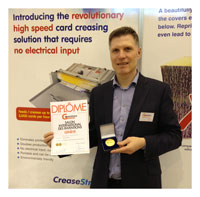 Most of us are accustomed to hearing about awards, usually bestowed one colleague to another by institutions from within our printing industry. But how would we fare out there in the big, bad world? Graham Harris decided to find out.
Most of us are accustomed to hearing about awards, usually bestowed one colleague to another by institutions from within our printing industry. But how would we fare out there in the big, bad world? Graham Harris decided to find out.
Graham, Managing Director of CreaseStream and Tech-ni-fold Ltd. decided to showcase his new CreaseStream Mini Quick-Feed at the International Exhibition of Inventions in Geneva, Switzerland. He says, "It was tough getting accepted for the exhibition in the first place as standards were high and the judging process was strict and rigorous. They were seeking only new creative steps in the field of invention and innovation that could be demonstrated beyond doubt."
With 725 exhibitors from 45 countries and nearly 1,000 inventions on display, competition for the prizes was indeed intense. The exhibition, said to be the largest of its kind in the world, is devoted solely to new products, techniques and inventions from all types of industries around the globe.
The effort paid off when judges awarded a Gold Medal to the CreaseStream Mini Quick-Feed in the category of Commercial and Industrial Equipment. They were impressed by how the Quick-Feed creased paper at a relatively high speed without the aid of a motor, vacuum pump or electrical input.
In his demonstration for the judges, Harris creased a 6 page brochure, digitally printed on cover stock with heavy ink coverage. The semi-automatic hand-cranked creasing machine produces about 3,000 sheets per hour, with Harris’ patented Tri-Creaser doing the creasing work and eliminating the fiber cracking inherent to these types of digital and offset jobs.
The patent-pending feeder system on the Quick-Feed loads from the top and feeds from the bottom, allowing for continuous operation. It also does this without marking or scuffing the sheets, thus eliminating a common problem often found in conventional friction-feed systems.
According to Harris, the driving idea behind the Quick-Feed was two-fold:
- Beat the output efficiency of some of the conventional automated creasing machines. The continuous-feed design of the machine is of, course, what allows such relatively high yields. Depending on the size of the sheet, it’s easy to produce up to 3,000 sheets or more per hour.
- Do so at a considerable cost-saving. The lack of motor, pumps or other electrical equipment saves considerable manufacturing cost which is passed along to the end user. This puts the retail price at a level that appeals to small quick printing shops or digital printing departments as well as to the larger printing company that wants to segregate its digital printing or short-run bindery work.
By accomplishing both goals, the Quick-Feed makes high-performance creasing and perforating accessible to a much broader audience. The small printer or the startup that can’t afford an automated creasing machine can now produce the same volume (or better) as with the automated system but at a much lower cost, and without the complexity that comes with automation.
The old adage “less is more” is really true in this case. I admit the hand crank seems to be a magnet for jokes. “Does that thing come with a monkey…” has been heard more than once on more than one continent. Yet out there in the jungle where there is no monkeying around, some seriously skeptical judges were convinced the Mini Quick-Feed deserved no less than a gold medal.
I’d say that Graham fared pretty well! So too will the users of this unique creasing and perforating machine. You can watch a brief video overview of the CreaseStream Mini Quick-Feed in action here.
And as always, we welcome your comments, suggestions and experiences below.

